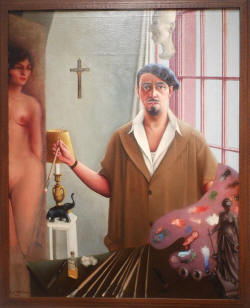

Queer Places:
Mount Olivet Catholic Cemetery
Chicago, Cook County, Illinois, USA

The Renaissance marked a period of a flourishing and renewed black psyche. There was a newfound appreciation of black artistic and aesthetic culture. Consequently, many black artists felt a moral obligation to create works that would perpetuate a positive representation of black people. During this time, Alain Locke coined the idea of the "New Negro", which was focused on creating progressive and uplifting images of blacks within society.[2] The synthesis of black representation and visual culture drove the basis of Motley's work as "a means of affirming racial respect and race pride."[3] His use of color and notable fixation on skin-tone, demonstrated his artistic portrayal of blackness as being multidimensional. Motley himself was of mixed race, and often felt unsettled about his own racial identity. Thus, his art often demonstrated the complexities and multifaceted nature of black culture and life.
When Motley was a child, his maternal grandmother lived with the family. She had been a slave after having been taken from British East Africa. She shared her stories about slavery with the family, and the young Archibald listened attentively. He describes his grandmother's surprisingly positive recollections of her life as a slave in his oral history on file with the Smithsonian Archive of American Art.[5]
During World War I, he accompanied his father on many railroad trips that took him all across the country, to destinations including San Francisco, Los Angeles, Hoboken, Atlanta and Philadelphia. It was this exposure to life outside Chicago that led to Motley's encounters with race prejudice in many forms. In his oral history interview with Dennis Barrie working for the Smithsonian Archive of American Art, Motley related this encounter with a streetcar conductor in Atlanta, Georgia:
I wasn't supposed to go to the front. So I was reading the paper and walking along, after a while I found myself in the front of the car. The conductor was in the back and he yelled, "Come back here you so-and-so" using very vile language, "you come back here. You must be one of those smart'uns from up in Chicago or New York or somewhere." It just came to me then and I felt like a fool. I was never white in my life but I think I turned white. I just stood there and held the newspaper down and looked at him. I walked back there. Then he got so nasty, he began to curse me out and call me all kinds of names using very degrading language. I just couldn't take it. And he made me very, very angry. I used to have quite a temper.[5]
Motley married his high school sweetheart Edith Granzo in 1924, whose German immigrant parents were opposed to their interracial relationship and disowned her for her marriage.[1]
His nephew (raised as his brother), Willard Motley, was homosexual and an acclaimed writer known for his 1947 novel Knock on Any Door.
My published books: